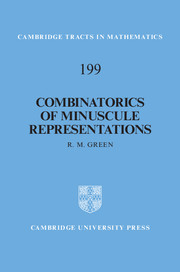Book contents
- Frontmatter
- Contents
- Introduction
- 1 Classical Lie algebras and Weyl groups
- 2 Heaps over graphs
- 3 Weyl group actions
- 4 Lie theory
- 5 Minuscule representations
- 6 Full heaps over affine Dynkin diagrams
- 7 Chevalley bases
- 8 Combinatorics of Weyl groups
- 9 The 28 bitangents
- 10 Exceptional structures
- 11 Further topics
- Appendix A Posets, graphs and categories
- Appendix B Lie theoretic data
- References
- Index
1 - Classical Lie algebras and Weyl groups
Published online by Cambridge University Press: 05 February 2013
- Frontmatter
- Contents
- Introduction
- 1 Classical Lie algebras and Weyl groups
- 2 Heaps over graphs
- 3 Weyl group actions
- 4 Lie theory
- 5 Minuscule representations
- 6 Full heaps over affine Dynkin diagrams
- 7 Chevalley bases
- 8 Combinatorics of Weyl groups
- 9 The 28 bitangents
- 10 Exceptional structures
- 11 Further topics
- Appendix A Posets, graphs and categories
- Appendix B Lie theoretic data
- References
- Index
Summary
One of the main goals of the first half of this book is to construct Lie algebras and Weyl groups from certain labelled partially ordered sets known as heaps. The formal definition of heaps is in terms of categories, which will be defined in Chapter 2. The purpose of Chapter 1 is to show how particular examples of heaps can be used to give combinatorial constructions of algebraic objects.
In Section 1.1, we summarize the basic properties of Lie algebras. In Section 1.2, we define the Lie algebras of types An, Bn, Cn and Dn in terms of matrices; that is, the Lie algebras sl(n + 1, V), so(2n + 1, V), sp(2n, V) and so(2n, V), respectively. Except in type Bn, the Lie algebra representations given by these matrices will turn out to be “minuscule”. Because of this, they may easily be constructed in terms of heaps (shown in Figures 1.1, 1.2 and 1.3) as we explain in Section 1.3. Finally, in Section 1.4, we define the classical Weyl groups of types An, Bn and Dn as abstract groups. We also explain how to construct the groups using the same three infinite families of heaps shown in Section 1.3.
Lie algebras
A Lie algebra is a vector space g over a field k equipped with a bilinear map [ , ] : g × g → g (the Lie bracket) satisfying the conditions
[x, x] = 0,
[[x, y], z] + [[y, z], x] + [[z, x], y] = 0,
for all x, y, z ∈ g. (These conditions are known respectively as antisymmetry and the Jacobi identity.)
Information
- Type
- Chapter
- Information
- Combinatorics of Minuscule Representations , pp. 5 - 18Publisher: Cambridge University PressPrint publication year: 2013
